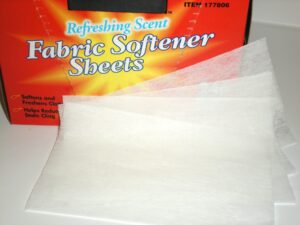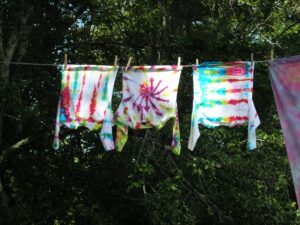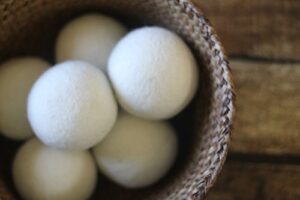 I see people from time to time asking about what dryer sheets and fabric softeners do, how they work, and what people can use instead to get rid of static in their laundry. I thought it was high time to address this issue.
I see people from time to time asking about what dryer sheets and fabric softeners do, how they work, and what people can use instead to get rid of static in their laundry. I thought it was high time to address this issue.
Fabric softeners and dryer sheets and bars perform similar functions. They coat the fibres in the fabric with oils and waxes to prevent the fibres from rubbing directly against one another and causing static electricity to form. These products also tend to contain fragrances and other chemicals, which are held onto the fabric by the oils and waxes. Fabric softeners additionally must contain preservatives, since they are a water-based formulation.
I never used fabric softener. My mom realized early on that it irritated my skin. I did use dryer sheets for many years. When I stopped using them, I had a bit of static in my laundry, but it has decreased over the years. Why? I don’t put wool or silk in the dryer. Since I realized I was allergic to synthetic clothing fibres, most of what I put in the dryer switched to cotton. Cotton does not create static electricity very easily. Therefore the more natural fibres you wear, the less you need to do anything at all.
Why might someone want to stop using dryer sheets or bars, or fabric softener, if they don’t have allergies?
- These products contain a lot of unknown chemicals. Fragrances alone can contain thousands of possible chemicals that do not have to be listed or even proven safe. Many contain sensitizing agents, meaning that over time your body can become more and more sensitive to them, with continued exposure. The fact that these chemicals are designed to coat and linger on clothing is even more disturbing, as your skin is porous, and the largest organ of your body.
- The waxes and oils from these products can build up on the inside of your washer/dryer, causing performance problems. Most of the time this buildup is minor, but even in smaller amounts it can cause sensors to stop functioning properly, which is why many newer machines caution their use. The waxes and oils can also build up on your clothing, causing dinginess.
- The waxes and oils in these products can reduce the absorbency of your towels. Towels rely on loose fibres that can absorb water and other liquids. Putting waxes and oils on the fibres prevents water from getting into the spaces between the fibres, limiting their ability to absorb.
- You care about the people you live and work with, your friends and family. There are many people around you who are affected by the fragrances and chemicals you are using. You may know of some people, or you may not, but they’re there. Most of the time they are forced to come into close contact with these chemicals, and your avoidance of these chemicals is very much appreciated.
- You’ll save money. Reusable or homemade methods can have anywhere from high to minimal cost, but all of them will save you money over the use of single-use products.
So what if you do need something to get rid of static in laundry? There are a few really neat options out there, and some basic ones you can do without buying anything. The majority of these rely on limiting static buildup directly from the dryer, but will not do quite as much to prevent static buildup during wear. For most clothing (socks, underwear, most pants, and most shirts, other than the really satiny, clingy ones), this is not an issue anyway.
 Hang your clothes to dry – It won’t prevent static electricity from forming on synthetic and silk fabrics while you’re wearing them, but it will prevent any static from forming before you even put them on. Likewise, you can spritz your clothing lightly with water when you pull it out of the dryer, for the same effect.
Hang your clothes to dry – It won’t prevent static electricity from forming on synthetic and silk fabrics while you’re wearing them, but it will prevent any static from forming before you even put them on. Likewise, you can spritz your clothing lightly with water when you pull it out of the dryer, for the same effect.
Reusable dryer sheets – Usually these are made out of a microfibre (read: polyester) fabric. It is the surface structure of the cloth that helps to dissipate the electric charges in the fabric as they tumble around the laundry in the dryer. This is not necessarily the best option if a person has an allergy to glycols (polyethylene glycol is used to make polyester), but it may be a good option for people with fragrance or preservative allergies.

Plastic Dryer Balls
Plastic dryer balls – These dryer balls have nubs all over them that beat the fabric into submission. Their materials, surface structure, and action again are the main actors in dissipating the charges the build up on the clothing fibres. Like the reusable dryer sheets, these may not be as good for people with allergies to glycols or sensitivity to plastics, especially since heating plastics tends to cause them to slowly start to break down, transferring some of their chemicals to the clothing.
Wool dryer balls – These are usually made of wool from sheep or alpacas. The presence of lanolin in the sheep wool-based balls helps to act like the waxes and oils in the disposable dryer sheets and fabric softeners, without adding any man made chemicals to your clothing (a possible concern for people with lanolin allergies). Wool also takes on charges easily, just like the hair on your head. Agitating wool with clothing, allowing the balls to occasionally dissipate the charge by contacting the metal drum of the dryer, seems to be quite effective at removing static charges from clothing. Since wool does felt together more heavily with agitation, and lanolin content of sheepswool balls will decrease over time, these do eventually wear out and need replacing. A note for people with glycol allergies – one of the common “safe” cleaners for wool, often used on organic wool, contains propylene glycol. I don’t know whether washing the wool with dilute vinegar might remove it, but I would definitely hesitate to use any surfactant (detergent or soap) on the balls, as it could wash away the lanolin too.

Wool Dryer Balls
Aluminum foil balls – Some people have tried everything else and found that simple balled-up pieces of aluminum foil gave them the best static-removing results. These balls would work similarly to the wool balls, but contain metal rather than wool and lanolin. They may be slightly more wearing on the inside of your dryer.
Buy less synthetic clothing – Synthetic fibres aren’t only subjecting your body to chemicals, they are also subjecting the environment to those chemicals, when they rub together, when they are washed, etc. Small fibre pieces break off all the time and get into the environment, where they eventually end up in our food supply chain. Natural fibres biodegrade to a much greater degree and can be digested by animals rather than causing unsafe buildup in their bodily systems. They are usually still treated with chemicals (buying organic can help minimize chemical exposure), but the chemical content of the fibres will decrease over time. These fibres are more likely to need to be hung to dry (such as wool and silk), but the ones that can be put in the dryer are less likely to create any static buildup.
Have you found other allergy-safe methods for reducing static in your laundry? Comment below.
